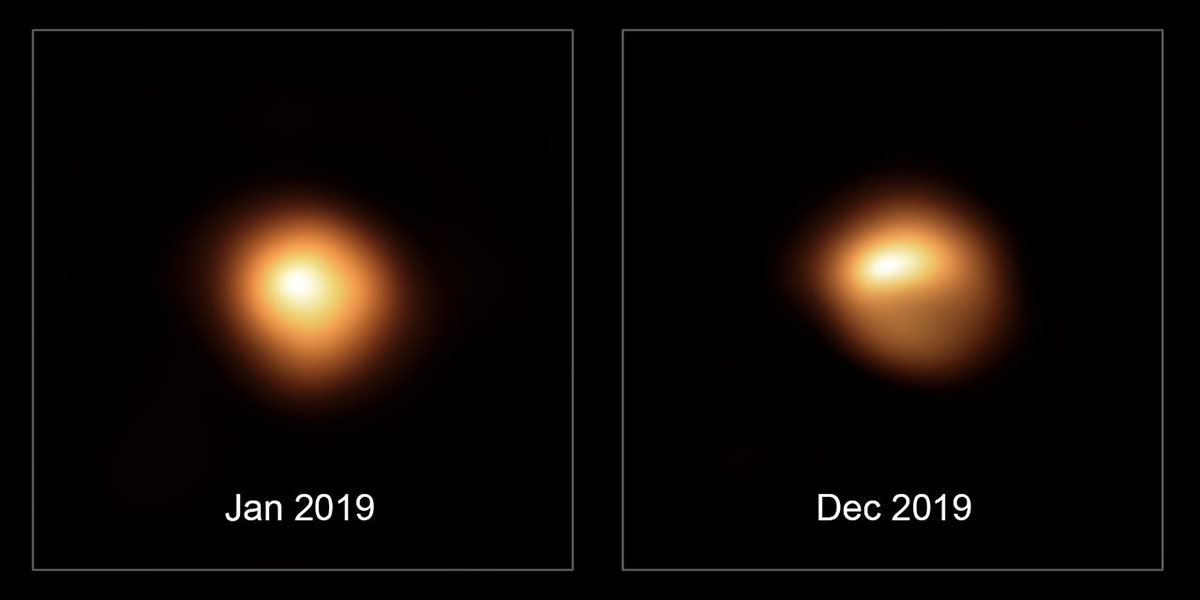

This comparison image shows the star Betelgeuse before and after its unprecedented dimming. The observations, taken with the SPHERE instrument on ESO’s Very Large Telescope in January and December 2019, show how much the star has faded and how its apparent shape has changed. Credit:ESO/M. Montargès et al.
Scientists around the world, including Catholic University Research Assistant Professor of Physics Gioia Rau, are closely watching the supergiant star Betelgeuse in anticipation of its explosion into a supernova. In recent weeks Betelgeuse — the brightest star in the Orion constellation — has dimmed significantly, and Rau and her colleagues are attempting to determine the reasons why and what they may portend.
As a supergiant star, Betelgeuse's demise in a massive detonation caused by its gravitational collapse (when the outward pressure of nuclear fusion is no longer sufficient to counteract the star's own weight) is not a question of "if," only "when." Astronomers generally predict the end will happen in a “short” time, somewhere in the next 100,000 years, which — to scientists who measure time on a galactic scale — is considered to be a short time.
Rau has experience working as a research scientist at NASA as part of the Center for Research and Exploration in Space Science & Technology (CRESST II), analyzing data from the Hubble Space Telescope, and at the European Southern Observatory (ESO) in Munchen, Germany, through which she has contributed to the data analysis and interpretation of recent images of Betelguese.
Betelguese is visible to the naked eye, which is why many stargazers, professionals and amateurs alike, are excited about the possibility of experiencing a supernova viewable to so many people on Earth, a relatively close 650 light-years away.
“The groundbreaking image of Betelgeuse’s photosphere, taken with the SPHERE instrument at the Very Large Telescope (VLT) in Chile, is one of the pieces of the puzzle that will help us to understand the causes of the dimming,” Rau said. “Indeed, the image clearly shows that the star not only has been dimming in its brightness, but has also changed its apparent shape. It’s important to understand the process that caused this dimming and any correlation with the variation in its apparent shape, as this could give us clues on what is going on now with the star.”
Although some are enthusiastic at the idea of an impending supernova, Rau remains cautious.
“The supernova is only one of the hypotheses, and currently controversial. More data is needed to truly understand the causes of Betelgeuse’s dimming,” she says. “Another possibility could be extraordinary stellar activity causing a cooling in Betelgeuse’s photosphe Or it could be an ejection of dust in our direction.
"We are continuing an observation campaign involving other instruments at VLT, and this will hopefully provide the other missing pieces of the puzzle to reconstruct the causes of this unprecedented dimming in Betelgeuse.”
For Duilia de Mello, professor of physics and vice provost for global strategies, a potential supernova involving Betelguese fills her with hope. De Mello discovered a supernova in another galaxy more than 50 million light years away, but Betelguese offers her hope closer to home.
“It will be the first supernova to explode so close since we started to understand the evolution of the stars,” de Mello wrote in January, reflecting on the scientific promise of the new decade. “The last supernova to explode in our galaxy was in 1604 and it was Johannes Kepler who studied it. Remember that Kepler had just demonstrated that the Earth was not the center of the universe; he had no idea that stars produce the chemical elements that make up the entire universe, including all forms of life.
“Today, with all the technology we have, we can explain to everyone on the face of the Earth that we are made of stardust. No one is different. We're all the same! If Betelgeuse explodes, it will surely make us reflect on life and the future of the planet.”